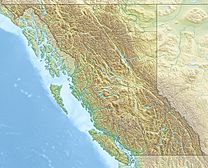Enid Creek Cone facts for kids
Quick facts for kids Enid Creek Cone |
|
|---|---|
| Highest point | |
| Geography | |
| Location | British Columbia, Canada |
| Geology | |
| Age of rock | Pleistocene |
| Mountain type | Subglacial mound |
| Volcanic arc/belt | Stikine volcanic belt |
Enid Creek Cone is a special kind of volcano found in northwestern British Columbia, Canada. It's not a tall, cone-shaped mountain like you might imagine. Instead, it's a mound that formed under a thick sheet of ice.
Contents
What is Enid Creek Cone?
Enid Creek Cone is known as a subglacial mound. This means it was created when lava erupted under a glacier or ice sheet. When hot lava meets cold ice, it cools very quickly. This fast cooling creates unique shapes and structures.
How Do Subglacial Mounds Form?
Imagine a volcano erupting deep under a huge sheet of ice. The lava pushes up against the ice. It melts some of the ice, but the ice also helps to shape the lava. The lava cools into a mound or hill. Sometimes, water from the melted ice can mix with the lava, making it even more explosive.
Where is Enid Creek Cone Located?
Enid Creek Cone is located in the beautiful and wild area of northwestern British Columbia, Canada. It is part of the Dark Mountain area. This region is known for its rugged mountains and vast wilderness.
When Did Enid Creek Cone Form?
Enid Creek Cone last erupted during a time called the Pleistocene epoch. This was a very long time ago! The Pleistocene epoch lasted from about 2.6 million years ago to about 11,700 years ago. During this time, much of the Earth was covered in huge glaciers and ice sheets. This is why Enid Creek Cone formed under ice.
The Ice Age Connection
The Pleistocene epoch is often called the "Ice Age." During this period, glaciers grew and shrank many times. These massive ice sheets covered large parts of North America, including British Columbia. Enid Creek Cone is a cool reminder of those icy times. It shows us how powerful nature can be, even under tons of ice!


